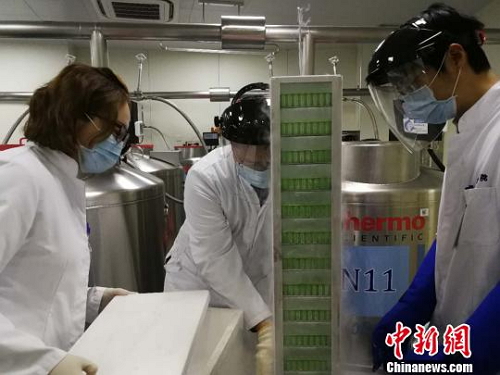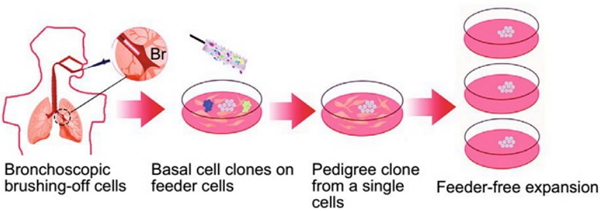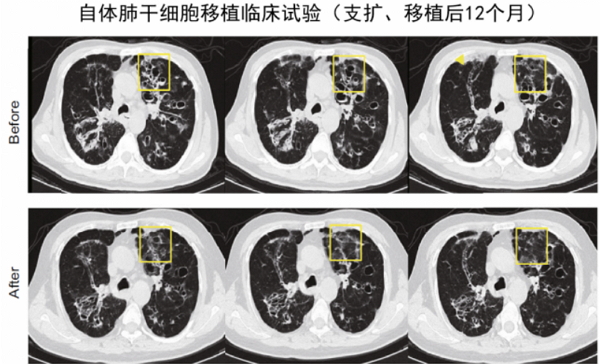Release date: 2018-02-13
Recently, Tongji University released a news: its medical team Zuowei professor team made breakthrough progress in the field of pulmonary regenerative medicine. Through the cooperation with Shanghai Oriental Hospital and the Southwest Hospital affiliated to the PLA Military Medical University, the world's first use of autologous lung stem cells was completed. Clinical trials to repair damaged lung tissue. This achievement fills a gap in this field, indicating that the regeneration of the human internal organs is gradually moving towards clinical application.

Image source: Protein & Cell (https://doi.org/10.1007/s13238-018-0506-y)
In recent years, the incidence of chronic lung diseases has been on the rise. Once fibrotic damage occurs in the lung tissue, the condition tends to worsen and is irreversible. Currently, traditional medical treatment can only slow down the pulmonary fibrosis process. Scientists are turning their attention to stem cell transplantation, hoping that cell therapy can solve this problem.
Now, the latest results of the team on the left have seen new hope for patients with chronic lung disease. This innovation was published in the journal Protein & Cell in the form of a cover article.

Left for the team to carry out relevant experiments (Source: China News Network)
Find human lung stem cells and verify on mice
In 2015, Professor Zuowei discovered p63+/Krt5+ adult stem cells in the lungs of mice, confirming their potential to regenerate lung tissue, including bronchioles and alveoli.
Subsequently, the team worked with the Jiangnan Stem Cell Research Institute in Zhejiang Province to move from animals to clinical trials. "The anatomy and development of human lungs are completely different from those of mice. Only through clinical research can we get close to the truth and finally find the answer." Professor Zuo Wei explained.
In the latest study, they found that a population of basal cells with SOX9+ markers possessed the characteristics of stem cells in the depressed folds of the bronchial epithelium of the lungs. Through cooperation with Professor Ren Tao of Shanghai Oriental Hospital, these stem cells were extracted from the lung tissue of patients by pulmonary bronchoscopy and cultured and expanded in vitro. These stem cells have good genetic stability and molecular phenotype.

Lung stem cell discovery, in vitro culture process (Source: BioArt)
To test the ability of lung stem cells to regenerate and repair lung tissue in patients, the researchers implanted GFP-labeled human lung stem cells into immunodeficient mice with lung injury. After 3 weeks, the results showed that human lung stem cells have been fused into mouse lung tissue to form a "human mouse chimera".
Further histological analysis showed that the transplanted stem cells successfully regenerated human bronchi and alveolar structures in the lungs of mice. More importantly, the host's capillaries surround the regenerated alveolar structure. This means that the regenerative organization has begun to function.
In addition, after receiving stem cell transplantation, the damaged pulmonary fibrosis area of ​​the mouse has been replaced by regenerated alveolar cells. Moreover, the lung function of the mice was significantly restored.
Successful clinical trial of autologous lung stem cell transplantation
Based on these ideal preliminary studies, in 2016, Zuowei team opened the world's first stem cell-based lung regeneration clinical trial at the Oriental Hospital and the Southwest Hospital affiliated to the PLA Military Medical University, and performed surgery on two patients – The lung stem cells are implanted into the lungs through a bronchoscope.
After 3 months of transplantation, the patient's lung function has begun to recover. One year later, the respiratory symptoms of both patients were significantly relieved, including coughing and difficulty breathing. A CT scan showed that the bronchiectasis was repaired. "Overall, the effect of stem cell transplantation is gratifying. In particular, we can observe the reversal of lung function in patients after treatment, which is the effect that traditional treatment methods can not achieve." Professor Dai Xiaotian from the Southwest Hospital Respiratory Department, who presided over the clinical study, said.
According to the National Medical Research Registration and Filing Information System, Zuo is the “Clinical Study of Human Autologous Bronchial Basal Cell (Lung Stem Cell) Transplantation for Interstitial Pulmonary Diseaseâ€, which was jointly led by the team and Ren Tao team. It has been approved as the National Health Planning Commission and Food. Stem cell clinical research project filed by the FDA.

Image source: Tongji University
So far, the research team has completed 80 cases of stem cell transplantation, including different types of respiratory diseases such as bronchiectasis, chronic obstructive pulmonary disease and interstitial lung disease. The lung function of these patients, especially the lung diffusion function, has been significantly improved. .
Professor Zuo Wei said that chronic lung disease will be expected to be overcome in the next five years.
Reference materials:
Tongji research team realizes the world's first human autologous lung stem cell transplantation regeneration
Researchers report first lung stem cell transplantation clinical trial
Source: Bio-Exploration
Hand Soap Liquid,Hand Foam Soap,Wash Hand Soap,Soap Hand Wash
Wuxi Keni Daily Cosmetics Co.,Ltd , https://www.wxkenidaily.com